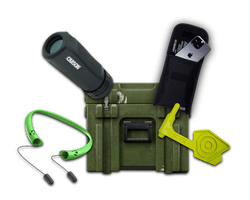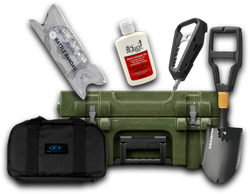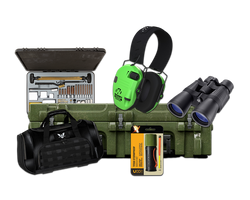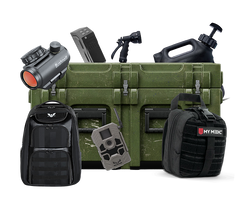
Concealment and Cover: Mastering Camouflage Techniques
In the realm of tactical operations, survival, and even wildlife photography, the ability to blend into your surroundings can be a game-changer. Camouflage techniques, which involve the use of concealment and cover, can help you avoid detection, whether you're tracking game in the wilderness or evading a potential threat in a conflict zone. This article will delve into the art of camouflage, offering insights into various techniques and their practical applications.
Understanding the Basics of Camouflage
Camouflage is a technique used to blend into the environment, making oneself or an object difficult to see or detect. It's a strategy that has been used by both animals and humans for survival, hunting, and warfare. The primary goal of camouflage is to deceive the observer and hide or obscure your presence.
There are several types of camouflage, each designed for specific environments or purposes. These include natural camouflage, where the colors and patterns match the surrounding environment; disruptive camouflage, which uses high-contrast patterns to break up the outline of the object or person; and countershading, where the coloration is darker on the top and lighter on the bottom, reducing the appearance of shadows and making the object or person appear flat and less noticeable.
In addition to these, there are also more specialized forms of camouflage. For instance, motion dazzle uses high-contrast patterns to confuse observers about the speed and direction of movement. Meanwhile, active camouflage changes to match the environment, much like a chameleon or an octopus.
Concealment vs. Cover
In the context of camouflage, it's important to understand the difference between concealment and cover. Concealment involves hiding from observation, making yourself or an object difficult to see. This can involve the use of natural features like vegetation or terrain, or man-made items like nets or paint.
Cover, on the other hand, provides protection from bullets, fragments, and other threats. It involves placing a barrier between yourself and the threat. While all cover provides concealment, not all concealment provides cover. For example, a bush might conceal you from view, but it won't protect you from bullets.
Understanding the difference between these two concepts is crucial in tactical situations. For instance, in a firefight, using cover can protect you from enemy fire, while concealment can keep you hidden from view. However, it's important to remember that while concealment can hide you from sight, it won't protect you from bullets or other threats.
Camouflage Techniques for Individuals
For individuals, effective camouflage involves a combination of clothing, equipment, and behavior. Here are some techniques to consider:
Camouflage Clothing: Choose clothing that matches the colors and patterns of your environment. This can include camouflage-patterned clothing or simple, earth-toned garments. Remember to consider all aspects of your appearance, including shoes, gloves, and headgear.
Camouflage Makeup: Camouflage makeup or face paint can be used to break up the distinctive features of the face and match the colors of the environment. Typically, lighter colors are used on darker areas of the face (like the eyes and lower part of the nose), and darker colors are used on lighter areas (like the cheeks and forehead).
Camouflage Equipment: Your equipment should also be camouflaged to match your clothing and the environment. This can involve painting weapons, covering shiny objects, and using camouflage covers or nets for larger items.
Movement and Behavior: The way you move and behave can also affect your visibility. Move slowly and carefully, avoid silhouetting yourself against the sky or other light backgrounds, and stay in the shadows whenever possible. Also, be aware of your environment and use natural features for concealment and cover.
Camouflage Techniques for Equipment and Installations
Camouflaging equipment and installations involves similar principles but on a larger scale. Here are some techniques to consider:
Camouflage Nets: Camouflage nets can be used to cover vehicles, tents, or other large equipment. These nets are typically colored to match the environment and may have 3D elements to break up the shape and shadow of the object. They can be draped over vehicles, tents, or other large equipment to quickly and effectively reduce their visibility. When using camouflage nets, it's important to ensure they fully cover the object and blend with the surrounding environment. Also, consider the shape and texture of the net; it should disrupt the object's outline and not create any unnatural patterns or shadows.
Camouflage Paint: Camouflage paint can be used to break up the shape of an object and match the colors of the environment. This can involve painting in patterns or using colors that blend into the surroundings. When using camouflage paint, consider the environment where the object will be used. For instance, in a forest environment, you might use a combination of greens and browns, while in a desert environment, you might use shades of tan and beige. Also, consider the pattern of the paint. Random patterns can be more effective than uniform patterns, as they better mimic the randomness of nature.
Natural Materials: Natural materials like branches, leaves, or grass can be used to conceal equipment or installations. These materials can be attached to nets or directly to the equipment, and should be replaced regularly to maintain their effectiveness. Using natural materials has the advantage of perfectly matching the local environment, as you're using elements from that environment. However, it can be more time-consuming to gather and apply these materials, and they can change over time (for instance, leaves can wilt or change color) and may need to be replaced frequently.
Disguise: In some cases, equipment or installations can be disguised as something else. This can involve the use of decoys, dummy positions, or other deceptive techniques. For instance, a military vehicle might be disguised as a civilian vehicle, or a radio antenna might be disguised as a tree. When using disguise, it's important to consider the perspective of the observer. The disguise should be convincing from all angles and at various distances. Also, consider the behavior associated with the disguise. For instance, if you're disguising a vehicle as a civilian vehicle, it should behave like a civilian vehicle (for instance, by following roads and traffic rules).
Terrain Masking: Terrain masking involves using the natural features of the terrain to conceal equipment or installations. This can involve placing objects in the shadow of a hill or behind a stand of trees, or using the natural contours of the terrain to hide the object. Terrain masking can be a highly effective way to conceal large objects, but it requires a good understanding of the terrain and how it will look from different angles and at different times of day.
Light and Shadow: Light and shadow can have a significant impact on how well camouflage works. Bright sunlight can create strong shadows that can give away the shape of an object, while overcast conditions can reduce shadows and make camouflage more effective. When camouflaging equipment or installations, consider the lighting conditions and how they will change throughout the day. You may need to adjust your camouflage as the lighting conditions change.
Training and Practice
Mastering camouflage techniques requires training and practice. This can involve studying the principles of camouflage, practicing the application of camouflage in various environments, and learning to observe and understand how others might see you. Training should also involve learning to think like an observer, understanding how factors like light, shadow, and movement can affect visibility.
There are many resources available for learning about camouflage, from books and online courses to hands-on training programs. These resources can provide valuable information and guidance, but the most important aspect of learning camouflage is practice. By regularly practicing your camouflage skills, you can improve your ability to blend into a variety of environments and situations.
Conclusion
Camouflage is a powerful tool in the tactical toolbox, offering a way to evade detection and gain the upper hand in various situations. Whether you're a soldier on a battlefield, a hunter tracking game, or a photographer capturing wildlife, mastering the art of concealment and cover can enhance your effectiveness and success. So grab your camouflage gear, head out into the field, and start practicing these techniques. Remember, the key to effective camouflage is observation, understanding, and adaptation. Stay prepared, stay hidden, and embrace the tactical lifestyle.
Photo by Kony Xyzx
Share this article








